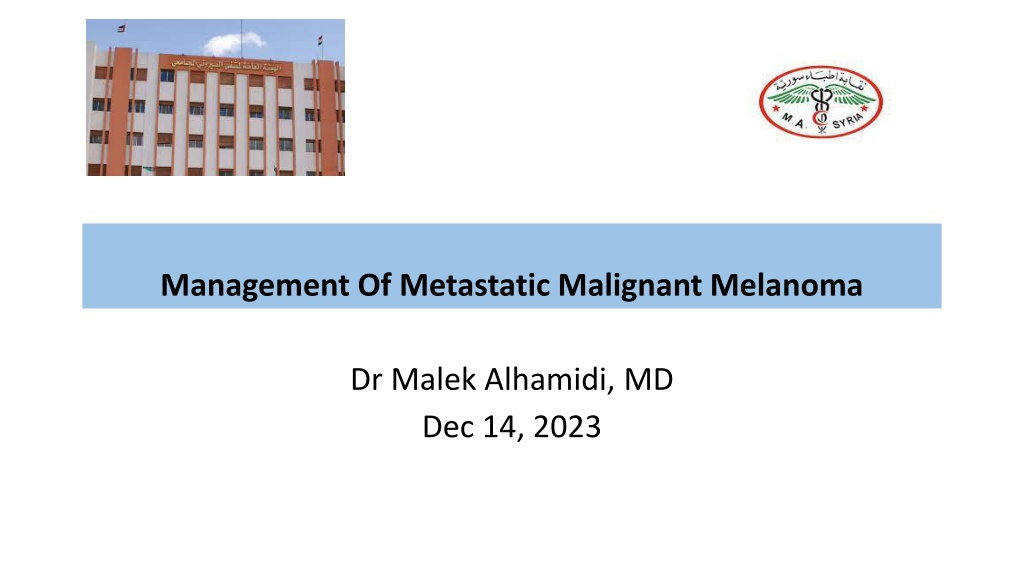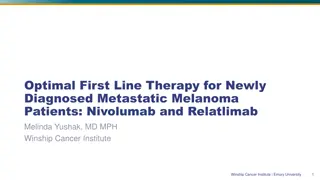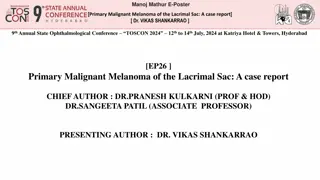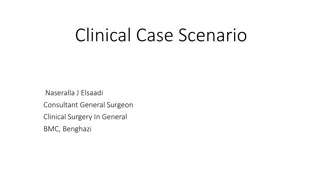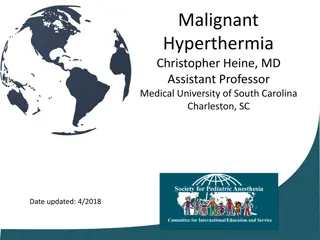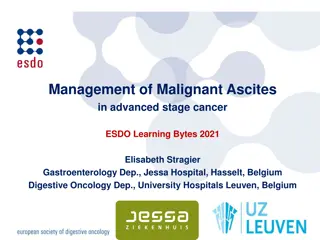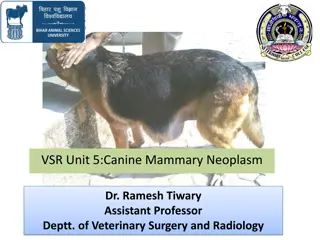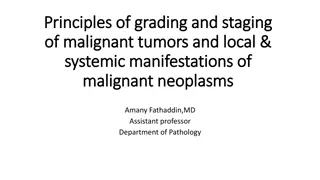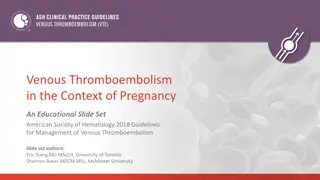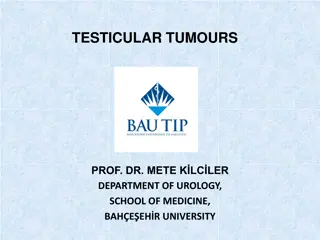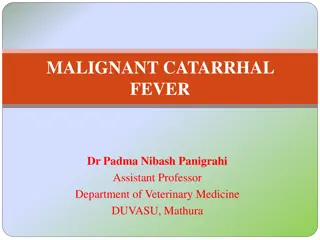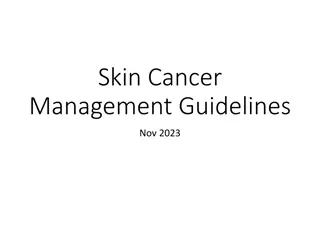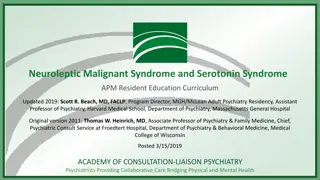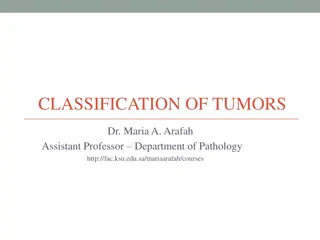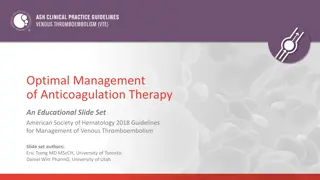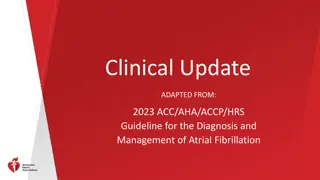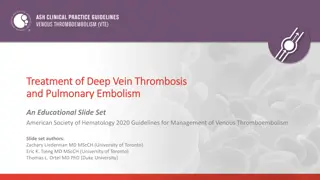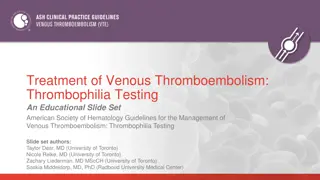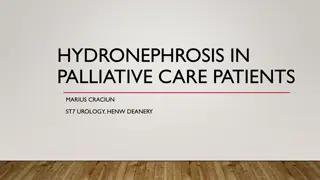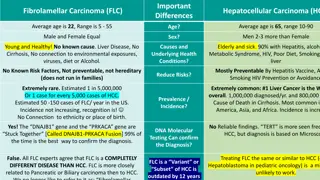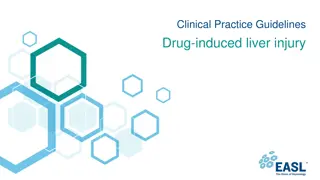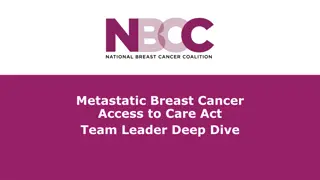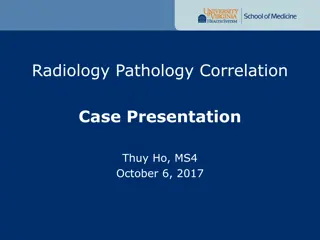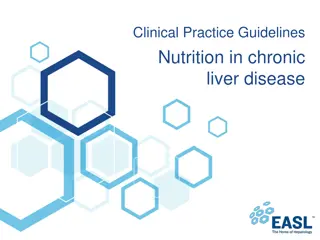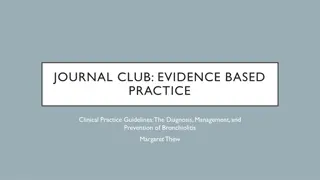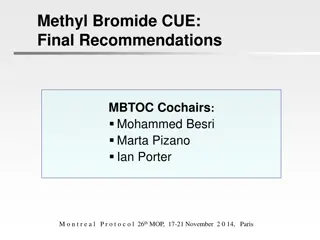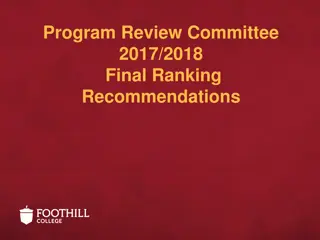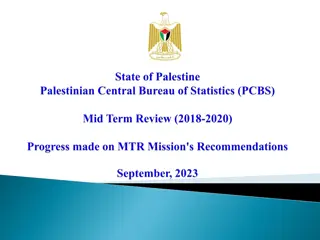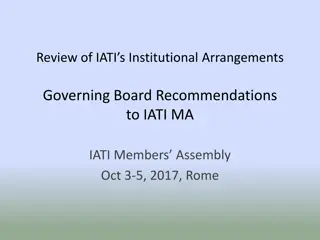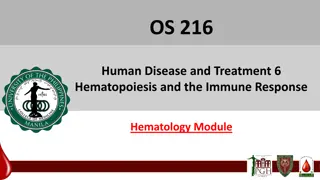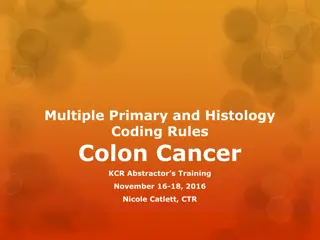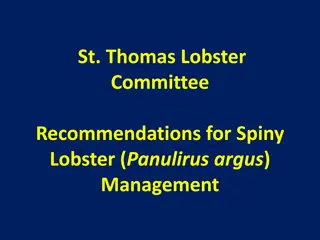Management of Metastatic Malignant Melanoma: Guidelines and Recommendations
The incidence of melanoma is rising rapidly, affecting both men and women. Advanced melanoma management involves multidisciplinary approaches and considerations for limited versus disseminated disease. Surgical resection or systemic therapy is recommended for limited metastatic disease, while disseminated disease can be managed through clinical trials, systemic therapy, local treatments, or supportive care. Local treatment options for extracranial metastases include intralesional injections, palliative resections, and radiation therapy. Stay updated on the evolving guidelines for effective melanoma management.
Download Presentation

Please find below an Image/Link to download the presentation.
The content on the website is provided AS IS for your information and personal use only. It may not be sold, licensed, or shared on other websites without obtaining consent from the author. Download presentation by click this link. If you encounter any issues during the download, it is possible that the publisher has removed the file from their server.
E N D
Presentation Transcript
Management Of Metastatic Malignant Melanoma Dr Malek Alhamidi, MD Dec 14, 2023
More melanoma patients will be diagnosed in the future Melanoma incidence is increasing in men more rapidly than any other malignancy and in women more rapidly than any other malignancy except lung cancer Between 2002 and 2006 the incidence of melanoma increased at an overall rate of 33% for men and 23% for women The guidelines of melanoma management continue to change dramatically
Advanced Melanoma Management Multidisciplinary tumor board consultation is encouraged for patients with stage IV metastatic melanoma Treatment depends on whether disease is limited (resectable) or disseminated (unresectable) Recommendations for Limited Metastatic Disease Recommendations for Disseminated Disease NCCN Guidelines Version 3,2023
Recommendations for Limited Metastatic Disease Resection, if feasible, or systemic therapy Observation is no longer a recommended option, even for patients with very limited stage IV disease Following systemic therapy, patients with resectable disease should be reassessed for surgery If completely resected, patients with no evidence of disease (NED) can be observed or offered adjuvant treatment Patients with residual disease following incomplete resection for limited metastases should be treated as for disseminated disease NCCN Guidelines Version 3,2023
Recommendations for Disseminated Disease Disseminated disease can be managed by one or more of the following options, depending on the location of and extent of metastatic disease: Clinical trial Systemic therapy Local treatment Best supportive care NCCN Guidelines Version 3,2023
Local treatment options Local treatment for extracranial metastases, may include: Intralesional injection with T-VEC Symptomatic extracranial metastases can be managed with palliative resection and/or radiation Radiation can be used for palliation of visceral, bone, and CNS metastases NCCN Guidelines Version 3,2023
Local treatment with T-VEC Talimogene laherparepvec (T-VEC) is a type of immunotherapy It's a treatment for melanoma skin cancer that has spread to other areas of the skin, soft tissue or the lymph nodes, and can't be removed with surgery (unresectable) T-VEC is a treatment using a weakened form of the cold sore virus. The changed virus grows in the cancer cells and destroys them. It also works by helping the immune system recognize and attack cancer cells NCCN Guidelines Version 3,2023
Local treatment with T-VEC T-VEC can be injected into nodal or distant metastases to help with disease control, but the impact on survival is not known It may be useful for patients with very limited stage IV disease, or in combination with other treatment modalities NCCN Guidelines Version 3,2023
Recommendations for First-line Systemic Therapy For first-line therapy of unresectable or distant metastatic disease, recommended treatment options include: Immune checkpoint inhibitors: Anti PD-1: Nivolumab, Pembrolizuab Anti CTLA-4: Ipilimumab BRAF-targeted therapy for patients with an activating BRAF V600 mutation Clinical trial NCCN Guidelines Version 3,2023
Recommendations for First-line Systemic Therapy Immune checkpoint inhibitor options in this setting include: Anti-PD-1 monotherapy with pembrolizumab (category 1) or nivolumab (category 1) Nivolumab/ipilimumab combination therapy (category 1) Immune checkpoint inhibitors have been shown to be effective regardless of BRAF mutation status (both BRAF mutant and BRAF wild-type metastatic disease) NCCN Guidelines Version 3,2023
Recommendations for First-line Systemic Therapy Immune checkpoint inhibitors Selection between anti-PD-1 monotherapy and nivolumab/ipilimumab combination therapy should be informed by the consideration that: Combination therapy may improve PFS Combination is associated with a much higher risk of serious immune-mediated toxicities Treatment selection should therefore be informed by consideration of the patient s overall health, medical history, concomitant therapies, comorbidities, and compliance with proactive monitoring and management of AEs NCCN Guidelines Version 3,2023
Recommendations for First-line Systemic Therapy Immune checkpoint inhibitors Relative indications for combination nivolumab/ipilimumab in comparison to PD-1 monotherapy include: Patient willingness to take on high risk of irAEs Absence of comorbidities or auto-immune processes that would elevate the risk of irAEs Patient social support and anticipated compliance with medical team to handle toxicities Absent/low tissue PD-L1 expression NCCN Guidelines Version 3,2023
Immune checkpoint inhibitors Kinetics of Response to Pembrolizumab In clinical trials the median time to response for pembrolizumab of approximately 12 weeks, similar to ipilimumab and nivolumab, and similar to chemotherapy Long-term follow-up from several studies has shown that late responses to pembrolizumab can be observed more than a year after the start of treatment, and that initial partial responses may become complete responses with time A pooled analysis of cohorts from KEYNOTE-001 with long-term follow-up (median 43 months) showed that 16% of patients achieved complete response, with median time to complete response of 12 months, ranging from 3 to 36 months Across trials long-term follow-up has shown that responses to pembrolizumab are very long-lived, with median duration ranging from 23 months (2 mg/kg Q3W arm in Keynote- 002) to much longer (eg, not reached even after 33.9 months follow-up in KEYNOTE-006) NCCN Guidelines Version 3,2023
Immune Related Adverse Events Treatment-related AEs occur in a high percentage of patients treated with anti-CTLA-4 or anti-PD-1 agents Grade 3 4 related AEs occur in 22% of patients receiving anti-PD-1 therapy 20% to 30% of patients receiving ipilimumab monotherapy 50% to 60% of patients receiving nivolumab/ipilimumab combination therapy Careful selection of patients and AE monitoring and management are therefore critical to safe administration of all of these agents NCCN Guidelines Version 3,2023
Immune Checkpoint Inhibitor Administration Among other factors, patient selection should take into consideration: Age Comorbidities (eg, disease processes whose manifestations might be confused with immune-related toxicities) Concomitant medications (eg, immunosuppressive therapies) Overall performance status Patients with underlying autoimmune disorders are generally excluded from treatment with immune checkpoint inhibitors NCCN Guidelines Version 3,2023
Immune Related Adverse Events They similar to autoimmune disorders Immune system sees healthy cells as a threat and attacks them Range from mild to life threatening Most are manageable if found and treated early Effects tend to be more severe when treatment includes both main types of ICIs Can occur during or after treatment More than one major organ may be affected May worsen with each dose of immunotherapy NCCN Guidelines, Version 3.2023: Management of ICIs Related Toxicities
Immune checkpoint inhibitors related toxicities Some irAEs may misattributed to: Infection Disease progression Pseudo-progression Early recognition of symptoms and prompt intervention are key goals for the management of irAEs NCCN Guidelines, Version 3.2023: Management of ICIs Related Toxicities
Management of immune checkpoint inhibitors related toxicities The primary facts of irAE management include: o Recognition and grading of toxicity o Immunosuppression: Corticosteroids then other immuno-suppressive agents o Individualized modification to ICI administration Significant irAEs o Often necessitate holding immunotherapy o Permanent discontinuation of the class of agent associated with toxicity in the setting of certain severe irAEs NCCN Guidelines, Version 3.2023: Management of ICIs Related Toxicities
Management of immune checkpoint inhibitors related toxicities Corticosteroids Are the mainstay of treatment for most high grade irAEs In the vast majority of irAEs, corticosteroids are rapidly effective If this is not the case and infection has been ruled out, additional immunosuppressive therapy should be considered Severe or steroid refractory irAEs may require administration of additional immunosuppressive agents For patients with severe irAEs not responsive to steroids within 48 to 72 hours, initiation of an additional immunosuppressant agent may be warranted in consultation with the relevant medical specialist NCCN Guidelines, Version 3.2023: Management of ICIs Related Toxicities
Management of immune checkpoint inhibitors related toxicities Corticosteroid Dose depends on the affected organ. For example, arthralgia induced by immunotherapies requires generally lower doses (0.2 0.4 mg/kg/day) compared with pneumonitis or colitis, which require higher doses (0.7 1.0 mg/kg/day) Appropriate duration and careful taper of corticosteroid therapy is important to prevent the recurrence of irAEs,the dose of corticosteroids should be given daily (preferably in the morning) until irAE resolution and must be then decreased gradually Full-dose corticosteroid treatment is typically given for 2 3 weeks, then tapered over 4 6 weeks and then withdrawn NCCN Guidelines, Version 3.2023: Management of ICIs Related Toxicities
Management of immune checkpoint inhibitors related toxicities Infliximab Is a monoclonal anti-TNF- ( tumor necrosis factor ) antibody used for treating various autoimmune diseases Can reactivate tuberculosis and hepatitis Infliximab blocks the interaction of TNF with its receptors, inhibiting induction of pro- inflammatory cytokines (IL-1, IL-6) and modulating the activity of immune effectors such as leukocytes, neutrophils, and eosinophils Infliximab has become a commonly used agent for treating steroid-refractory irAEs that develop during ICI therapy Duration of therapy with Infliximab for irAEs is not clearly defined, but is typically a single dose NCCN Guidelines, Version 3.2023: Management of ICIs Related Toxicities
Management of immune checkpoint inhibitors related toxicities Vedolizumab Is an integrin antagonist that binds to 4 7 integrin, blocking its interaction with mucosal addressin cell adhesion molecule-1 (MAdCAM-1), inhibiting the migration of T cells across the endothelium into inflamed GI tissues Vedolizumab is currently indicated for treating GI inflammation due to ulcerative colitis and Crohn s disease Case reports have described the use of vedolizumab for treating ICI-induced enterocolitis Vedolizumab may provide more specific immune suppression for the inflamed GI mucosa, hence theoretically sparing systemic immune suppression and anti- tumor immune responses NCCN Guidelines, Version 3.2023: Management of ICIs Related Toxicities
Recommendations for First-line Systemic Therapy BRAF-Targeted Therapies Approximately half of patients with metastatic cutaneous melanoma harbor an activating mutation of BRAF, an intracellular signaling kinase in the MAPK pathway Most BRAF-activating mutations occurring in melanomas are at residue V600 (usually V600E but occasionally V600K or other substitutions) BRAF inhibitors have been shown to have clinical activity in unresectable metastatic melanomas with BRAF V600 mutations Co-administration of inhibitors of MEK, a signaling molecule downstream of BRAF, potentiates these effects Efficacy and safety data from large randomized trials testing BRAF and MEK inhibitors have significantly impacted the recommended treatment options for patients with BRAF mutation positive unresectable advanced melanoma NCCN Guidelines Version 3,2023
Recommendations for First-line Systemic Therapy For patients with unresectable or distant metastatic disease harboring a BRAF V600- activating mutation The NCCN Panel recommends that BRAF mutational status should be tested using an FDA-approved test or by a facility approved by the Clinical Laboratory Improvement Amendments (CLIA) Positive immunohistochemistry (IHC) staining of tumor for VE1 is sufficient for starting targeted therapy in patients who are symptomatic or have rapidly progressing disease Due to risk of false positives and false negatives, all VE1 IHC results, both positive and negative, should be confirmed by sequencing The NCCN Panel recommends that tissue for genetic analysis be obtained from either biopsy of a current metastasis (preferred) or from archival material NCCN Guidelines Version 3,2023
Recommendations for First-line Systemic Therapy For patients with unresectable or distant metastatic disease harboring a BRAF V600- activating mutation, BRAF-targeted therapy first-line options include: BRAF/MEK inhibitor combination therapy with: Dabrafenib/trametinib Vemurafenib/cobimetinib Encorafenib/binimetinib All of these regimens are category 1 options based on results from phase 3 trials in the first-line setting (ie, COMBI-d, COMBI-v, CoBRIM, COLUMBUS) NCCN Guidelines Version 3,2023
Recommendations for First-line Systemic Therapy For patients with unresectable or distant metastatic disease harboring a BRAF V600- activating mutation Although vemurafenib and dabrafenib are FDA approved as single-agent therapy for treatment of patients with distant metastatic or unresectable melanoma with BRAF V600E mutation, these agents are almost never given without concomitant MEK inhibition BRAF/MEK inhibitor combination therapy has been shown to have superior response rate, PFS, and OS compared with BRAF inhibitor monotherapy, as well as a similar or better toxicity profile, so the NCCN Panel recommends BRAF inhibitor monotherapy only in those rare cases where combination therapy is contraindicated In such cases, BRAF inhibitor monotherapy remains a treatment option especially if the patient is not an appropriate candidate for immune checkpoint inhibitor therapy NCCN Guidelines Version 3,2023
Recommendations for First-line Systemic Therapy For patients with unresectable or distant metastatic disease harboring a BRAF V600- activating mutation Although trametinib is FDA approved for single-agent use to treat patients with unresectable or metastatic melanoma with BRAF V600E mutation, trametinib monotherapy is no longer an NCCN-recommended treatment option due to relatively poor efficacy compared with BRAF inhibitor monotherapy and BRAF/MEK inhibitor combination therapy NCCN Guidelines Version 3,2023
Prevention and Management of BRAF Inhibitor Toxicities The risk of toxicity (all grade, grade 3 5) was similar for BRAF/MEK inhibitor combination therapy compared with single-agent BRAF inhibitor therapy BRAF inhibitor monotherapies and BRAF/MEK inhibitor combinations, were associated with high rates of flu-like symptoms: pyrexia and chills, fatigue and asthenia, headache, various types of musculoskeletal aches and pains (eg, arthralgia, myalgia), and gastrointestinal upset (eg, diarrhea, nausea, vomiting): BRAF/MEK inhibitor combination therapy was associated with higher risk of pyrexia and diarrhea BRAF inhibitor monotherapy was associated with higher risk of musculoskeletal complaints NCCN Guidelines Version 3,2023
Prevention and Management of BRAF Inhibitor Toxicities Pyrexia Fever is common in patients receiving BRAF-targeted therapy 55% of BRAF/MEK combination patients 20% of BRAF inhibitors monotherapy patients Is often episodic The onset is often 2 to 4 weeks after start of treatment Median duration 9 days Pyrexia may be associated with chills, night sweats, rash, dehydration, electrolyte abnormalities, and hypotension NCCN Guidelines Version 3,2023
Prevention and Management of BRAF Inhibitor Toxicities Pyrexia Pyrexia should be managed by treatment discontinuation and use of anti-pyretics such as acetaminophen and/or NSAIDs Stopping or holding BRAF/MEK inhibitor therapy at the onset of pyrexia will often interrupt the episode Treatment can be resumed with full dose upon cessation of pyrexia and pyrexia related symptoms Upon re-exposure to BRAF/MEK inhibitors repeat pyrexia events can occur but grade> 3 events are uncommon (21%) If prolonged or severe pyrexia not responsive to BRAF/MEK inhibitors discontinuation, low dose steroid (prednisolone 10 mg) can be used Antipyretics as needed and increase fluid intake NCCN Guidelines Version 3,2023
Selection between first-line immune checkpoint inhibitors or BRAF-targeted therapy For patients with documented BRAF V600 mutations, selection between first-line immune checkpoint inhibitors or BRAF-targeted therapy can be difficult given the lack of comparative phase III clinical trials Clinical trials are underway to address unanswered questions regarding the optimal sequencing and/or combination of these agents The recommendation for first-line systemic therapy should be informed by: The tempo of disease The presence or absence of cancer-related symptoms The patient s personal history of autoimmune disease or estimated risk (based on family history) of triggering autoimmunity by immunotherapy NCCN Guidelines Version 3,2023
Selection between first-line immune checkpoint inhibitors or BRAF-targeted therapy Given that responses to immune checkpoint inhibitors can take longer to develop, BRAF-targeted therapy may be preferred in cases where the disease is symptomatic or rapidly progressing or the overall health of the patient appears to be deteriorating Other patients with asymptomatic metastatic melanoma may be good candidates for immune checkpoint inhibitor therapy, as there may be time for a durable antitumor immune response to emerge Safety profiles and AE management approaches differ significantly for BRAF-targeted therapy versus immune checkpoint inhibitor therapy; treatment selection should therefore be informed by consideration of the patient s overall health, medical history, concomitant therapies, comorbidities, and compliance NCCN Guidelines Version 3,2023
When to Discontinue Treatment or Switch Systemic Therapy ? A switch in systemic therapy is appropriate if there is confirmed disease progression during or after the course of systemic therapy Additionally, for those treated with BRAF-targeted therapy who have achieved maximum clinical benefit (but not complete remission), a switch to immune checkpoint inhibitor therapy may be considered Although there is no standard definition for maximum clinical benefit, it is commonly defined as no additional tumor regression on at least 2 consecutive scans taken at least 12 weeks apart NCCN Guidelines Version 3,2023
When to Discontinue Treatment or Switch Systemic Therapy ? However, for patients on BRAF-targeted therapy with limited subsequent treatment options (ie, those who have already failed or are ineligible for immune checkpoint inhibitor therapy), it is not unreasonable to continue BRAF targeted therapy beyond confirmation of partial response or stable disease, as changing to less effective treatments may result in disease progression The optimal duration to administer BRAF-targeted therapy after achieving a durable complete response, partial response, or stable disease is not known NCCN Guidelines Version 3,2023
When to Discontinue Treatment or Switch Systemic Therapy ? For patients treated with immune checkpoint inhibitors, late responses or late improvements in response may occur Some NCCN panel members may occasionally continue immune checkpoint inhibitor treatment beyond progression, as development of response after initial progression (sometimes referred to as pseudo-progression ) has been described Therefore, in patients treated with immune checkpoint inhibitors it is recommended that progression be confirmed before deciding to switch to a different type of therapy This is especially important in patients with limited options for subsequent therapy (ie, those who are BRAF-V600 wild-type) NCCN Guidelines Version 3,2023
When to Discontinue Treatment or Switch Systemic Therapy ? For patients who achieve complete response, partial response, or stable disease while on an immune checkpoint inhibitor, the optimal duration to administer therapy after achieving best clinical response remains unknown Although exploratory analyses of prospective trials show high durability of responses long after discontinuation of immune checkpoint inhibitor therapy, there are no prospective randomized trial data comparing treatment for a defined duration versus ongoing treatment after best clinical response is achieved Absent high-quality prospective data, there is a wide range of clinical practice NCCN Guidelines Version 3,2023
Recommendations for Second-line or Subsequent Therapy Interleukin-2 In one retrospective analysis of 305 patients who received IL-2 monotherapy for previously treated measurable metastatic disease, complete response was achieved in 4%, with median duration of response >176 months (range, 12 months to >253 months). Of the 12 patients with complete response, 10 survived at least 13 years A retrospective comparative study found that response rate for high-dose IL-2 was higher among patients with prior ipilimumab treatment compared with patients with no prior immune checkpoint inhibitor therapy (ORR 21% vs. 12%) High-dose IL-2 is associated with significant toxicities. Safe and effective administration requires careful selection of patients, close monitoring, and adherence to administration and AE management protocols High-dose IL-2 therapy should be restricted to institutions with medical staff experienced in the administration and management of these regimens NCCN Guidelines Version 3,2023
Recommendations for Second-line or Subsequent Therapy Interleukin-2 Although associated with significant risk of severe toxicity, IL-2 remains an option in the second-line or subsequent setting because it can provide long-term survival for the small percent of patients (<10%) with complete response Due to the low response rate and high toxicity, however, IL-2 is not a preferred option as it is considered less safe and less effective than immune checkpoint inhibitors or BRAF-targeted therapy options NCCN Guidelines Version 3,2023
Recommendations for Second-line or Subsequent Therapy Management of Interleukin-2 Toxicities Caution is warranted in the administration of high-dose IL-2 due to the high degree of toxicity reported If IL-2 is considered, the NCCN Panel recommends patients to receive treatment at institutions with relevant expertise Contraindications for IL-2 include inadequate organ reserve, poor performance status, and untreated or active brain involvement Additionally, panelists raised concerns over potential synergistic toxicities between ipilimumab and high-dose IL-2 therapy, especially in the gastrointestinal tract NCCN Guidelines Version 3,2023
Recommendations for Second-line or Subsequent Therapy T-VEC Ipilimumab Based on the results from a randomized phase II trial showing that intralesional T-VEC improved response rate in patients treated with systemic ipilimumab, this combination is listed as an option for patients with injectable metastases Because results of the trial did not demonstrate improved PFS or OS, ipilimumab/T-VEC combination therapy is a category 2B recommendation, only listed as an option for second or subsequent-line therapy (not first-line therapy), and is not a preferred option NCCN Guidelines Version 3,2023
Recommendations for Second-line or Subsequent Therapy Imatinib Although activating KIT mutations are present in only 3% of all melanomas, they are present in 39% of mucosal melanomas , 36% of acral lentiginous melanomas , and in 28% of chronically skin damaged melanomas (chronic solar damage) For those who have activating KIT mutations, imatinib may be helpful for disease control Phase II studies testing imatinib or nilotinib, inhibitors of mutated KIT, in patients with KIT-mutated or KIT-amplified metastatic melanomas demonstrated 17% to 30% ORR and 35% to 57% disease control rate Unfortunately, most of these responses were of limited duration These phase II studies included a significant portion of patients with non-cutaneous melanoma (29% 71% mucosal) The results show trends toward better response for patients with KIT mutations versus amplifications alone, and in some studies trends toward better response in mucosal melanoma compared with acral/CSD subtypes NCCN Guidelines Version 3,2023
Recommendations for Second-line or Subsequent Therapy Imatinib Among patients with activating KIT mutations, fewer than half responded to imatinib, and randomized trials to assess impact on PFS and OS have not been conducted For these reasons imatinib is not listed as a preferred agent, even for patients with qualifying mutations, but may be useful for those who are ineligible for or unresponsive to more effective therapies (ie, immune checkpoint inhibitors, BRAF-targeted therapy) NCCN Guidelines Version 3,2023
Recommendations for Second-line or Subsequent Therapy Cytotoxic Therapy Common cytotoxic agents being used in patients with metastatic melanoma include dacarbazine, temozolomide, and paclitaxel with or without carboplatin These have demonstrated modest response rates less than 20% in first-line and second- line settings Although early clinical trials suggested that nab-paclitaxel may provide higher response rates (22% 26% in phase II trials among chemotherapy-na ve patients with metastatic melanoma), a phase III trial of patients with chemotherapy-na ve stage IV melanoma showed that nab-paclitaxel did not result in higher rates of response compared with dacarbazine (15% vs. 11%; P = .239) This and other phase III randomized trials comparing chemotherapy regimens have failed to identify any regimens that provide both better response and OS relative to their counterparts NCCN Guidelines Version 3,2023
Recommendations for Second-line or Subsequent Therapy Cytotoxic Therapy Cytotoxic therapy is not among the preferred options for systemic therapy, even in previously treated patients For those who have failed or are ineligible for more effective options, however, cytotoxic therapy may be considered Remarkable responses to cytotoxic therapies are occasionally observed, and these approaches can help with disease control or to reduce tumor load NCCN Guidelines Version 3,2023
Recommendations for Second-line or Subsequent Therapy Best Supportive Care Given the number of effective options to choose from, active treatment is appropriate for most patients Best supportive care is usually reserved for those: With very poor performance status Who have experienced progression despite multiple lines of therapy Are ineligible for the preferred systemic treatment options NCCN Guidelines Version 3,2023
Recommendations for Treatment of Patients with Brain Metastases For patients with brain metastases, treatment of the CNS disease usually takes priority in an effort to delay or prevent intratumoral hemorrhage, seizures, or neurologic dysfunction Treatment of melanoma brain metastases is based on Symptoms Number of lesions present Location of the lesions NCCN Guidelines Version 3,2023
Therapy for Advanced Melanoma With Brain Metastases Brain Metastases: Efficacy of Immune Checkpoint Inhibitors In 6 prospective clinical trials , four were studying patients with brain metastases only. Of these, only CA209-170 included a randomized comparison, testing combination therapy versus nivolumab monotherapy in patients with asymptomatic brain metastases In aggregate, these trials show that brain metastases can respond to immune checkpoint inhibitors including ipilimumab monotherapy, antiPD-1 monotherapy, and ipilimumab/nivolumab combination therapy What these data do not provide is any robust comparison of agents for treatment of brain metastases even asymptomatic brain metastases It is tempting to conclude that nivolumab/ipilimumab combination therapy provides better intracranial responses rates than anti-PD-1 monotherapy, and that anti-PD-1 monotherapy likely provides higher response rates and better OS than ipilimumab monotherapy However, it is important to note that the populations tested may vary considerably across trials, and that the sample sizes are too small for meaningful statistical comparisons NCCN Guidelines Version 3,2023
Therapy for Advanced Melanoma With Brain Metastases BRAF-Targeted Therapies for Brain Metastases Patients with active brain metastases were excluded from prospective comparative trials testing BRAF-targeted therapies Patients with stable asymptomatic brain metastases were sometimes allowed, but for many of these studies this subpopulation was small Several prospective non-comparative trials have tested single-agent dabrafenib, single-agent vemurafenib, and dabrafenib/trametinib combination in patients with brain metastases Some of these studies included patients with symptomatic brain metastases, and some included patients whose intracranial disease had progressed after local therapy Studies included patients who had prior systemic therapy for metastatic disease, but most excluded patients with prior BRAF inhibitor therapy Results from these trials show that melanoma brain metastases can respond to BRAF inhibitor monotherapy or BRAF/MEK inhibitor combination therapy, albeit with lower response rates than for extracranial disease NCCN Guidelines Version 3,2023
